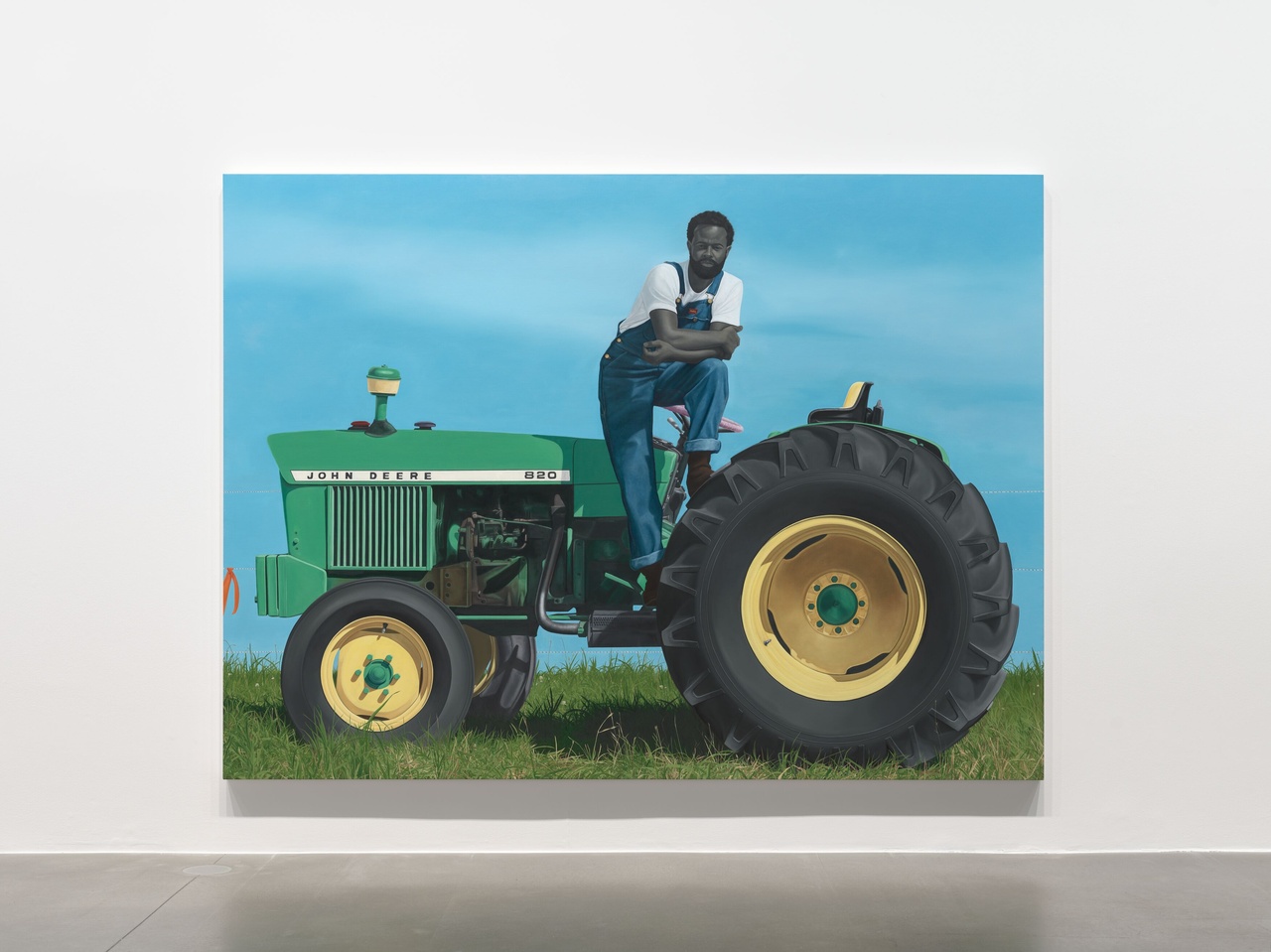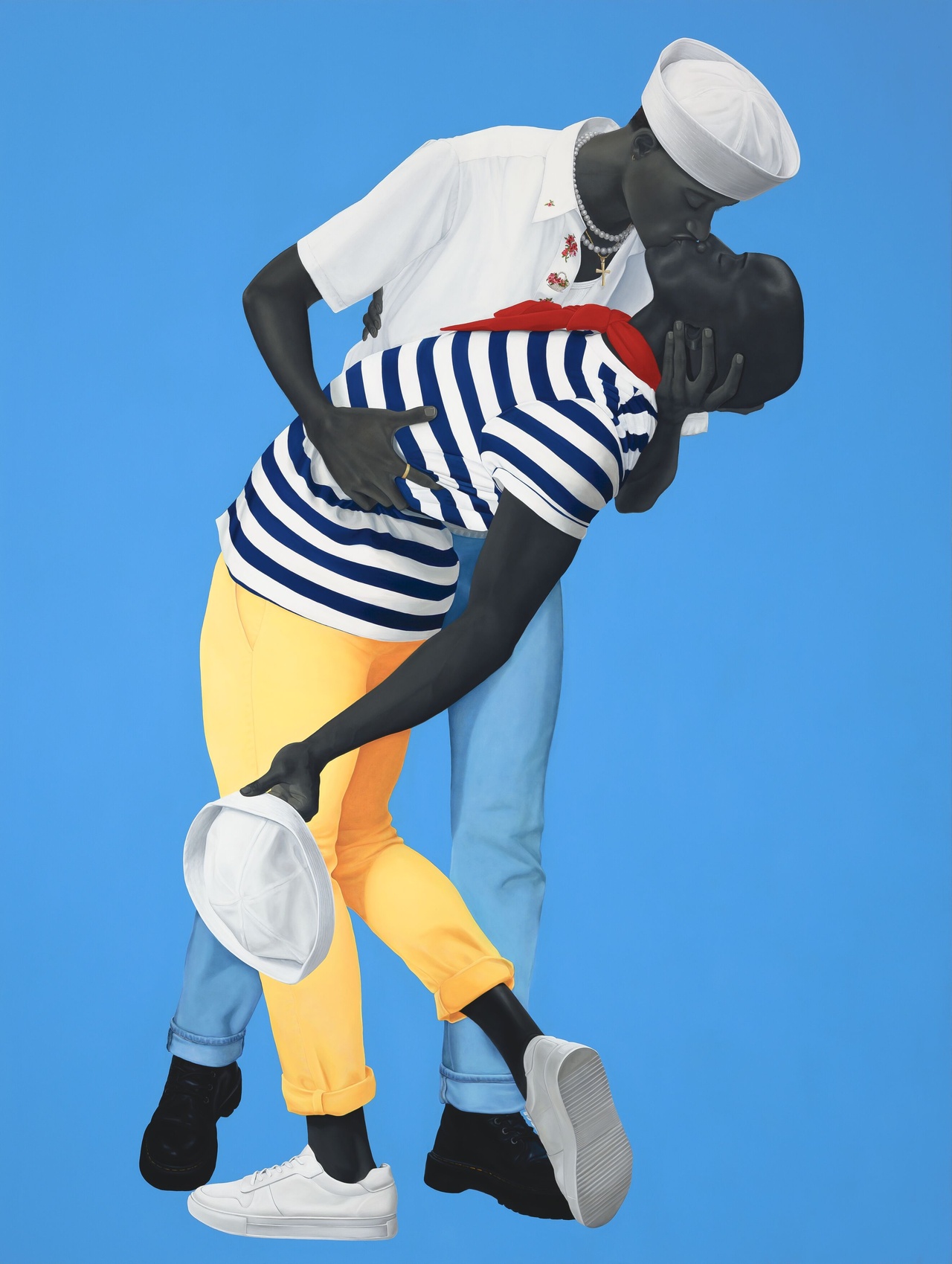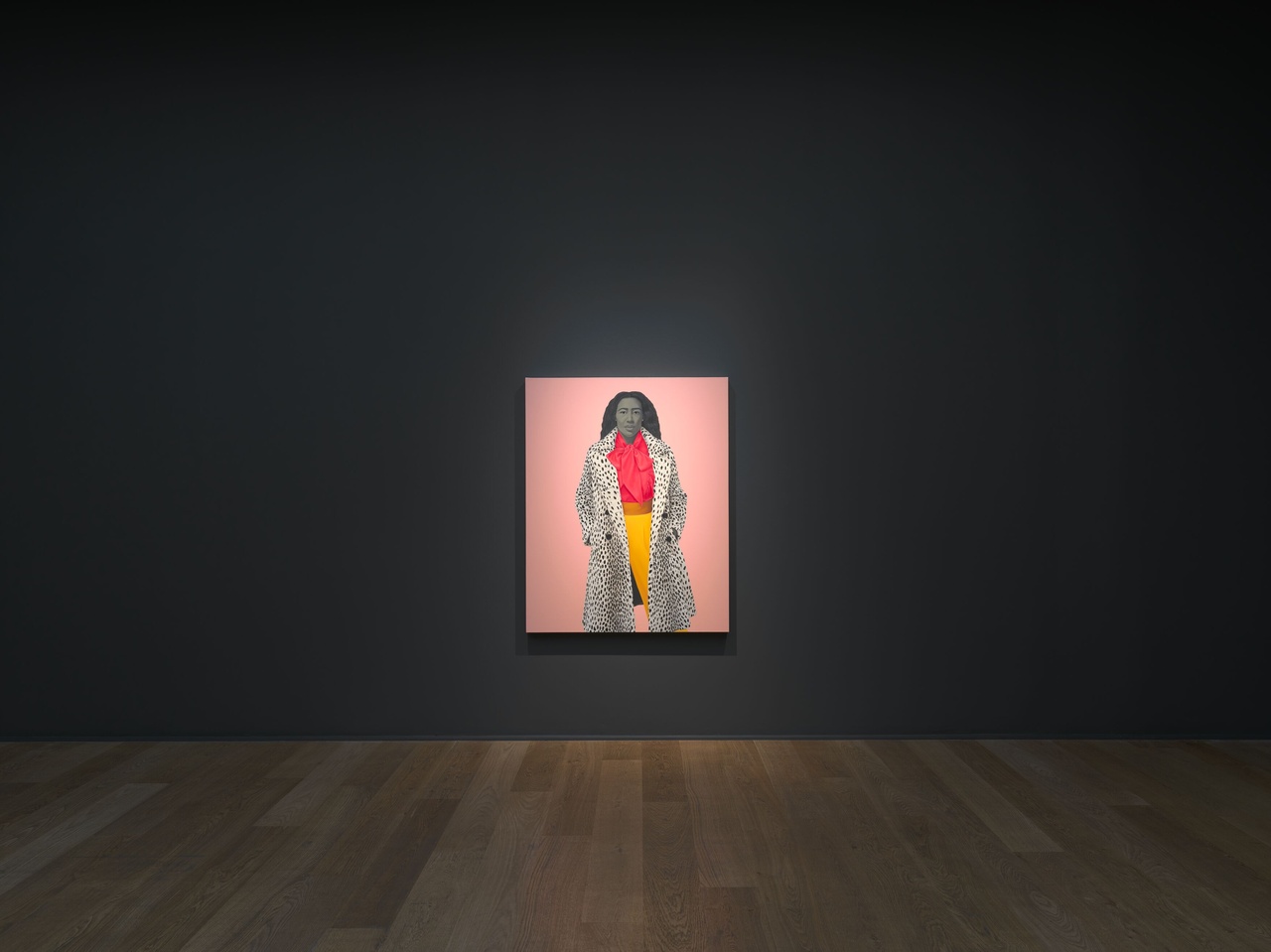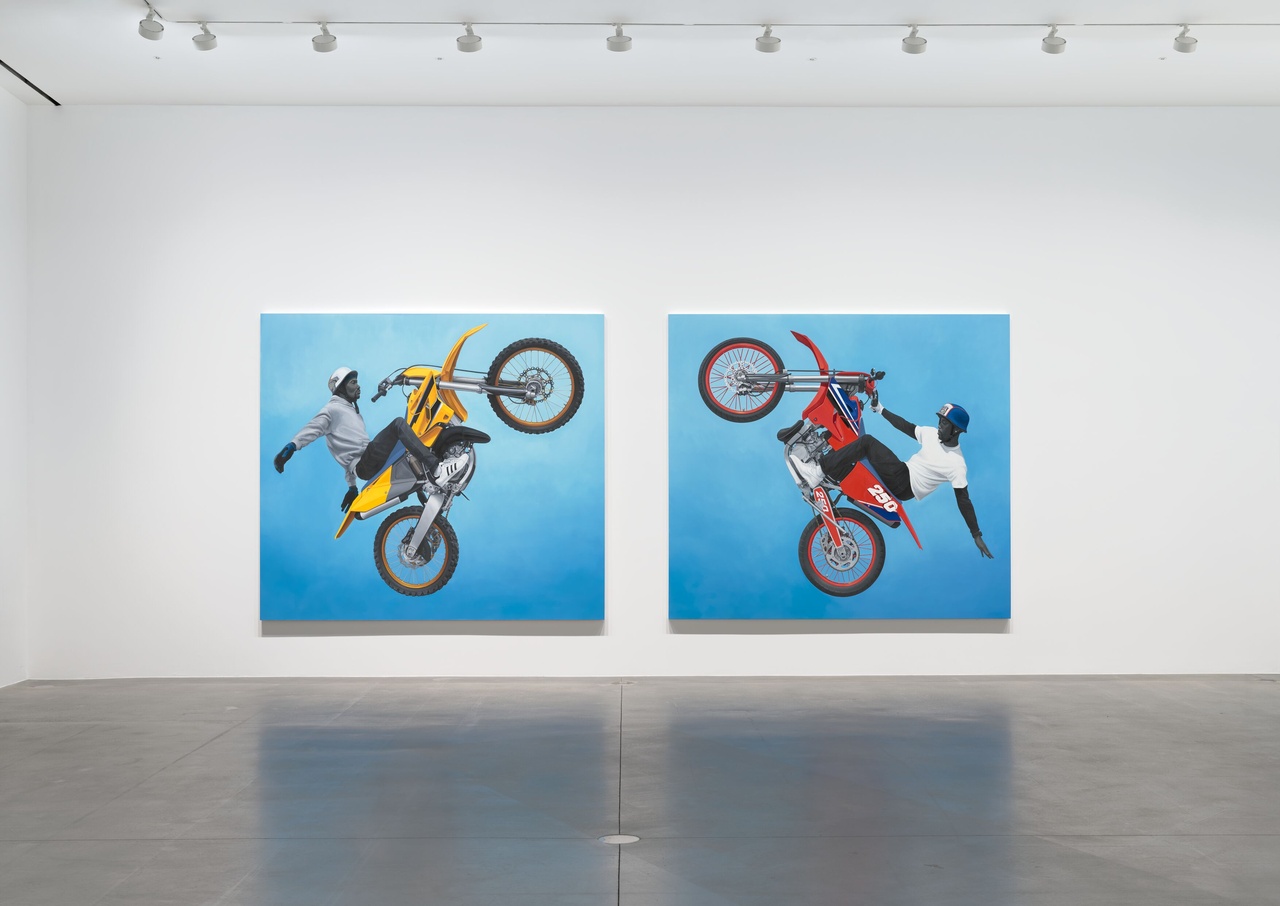A WORLD WORTH PORTRAYING Orit Gat on Amy Sherald at Hauser & Wirth, London

Amy Sherald, “A God Blessed Land (Empire of Dirt),” 2022
Amy Sherald, a portraitist who has risen to global fame in the past few years, is showing a restrained, sparse exhibition of ten large-scale paintings displayed across Hauser & Wirth’s two London spaces. Six in one gallery, four next door, the works on view do not break from Sherald’s recognizable style – portraits of Black subjects against flat, monochrome backgrounds that hint at the history of art while sitting comfortably in the contemporary world. As soft as she is… (2022) draws on Italian painter Giorgio de Chirico’s 1940 portrait of his wife Isabella Pakzswer Far, Lady in Leopard Coat, only the subject’s seated posture changes in Sherald’s hand to a standing, frontal image of a woman wearing a leopard-print coat over a red blouse combined with yellow trousers, positioned against a powdery-rose background. Where the image of de Chirico’s wife feels passive and polite, the softness Sherald addresses in the title feels like the result of confidence, not compliance. A similar maneuver happens in the two-person portrait For love, and for country (2022), which recreates Alfred Eisenstaedt’s famous photograph from Victory over Japan Day in Times Square in 1945. Sherald’s painting references the couple’s pose from the photo: the sailor’s embrace, supporting the back of their love object, who leans back, one leg up, caught in the moment. In the three-by-two-and-a-half meter painting, the sailor’s is still in uniform, and the love object becomes another man, wearing yellow trousers and a striped shirt, and holding a sailor’s cap.

Amy Sherald, “For love, and for country,” 2022
The four paintings on view in the second gallery form a loose series. Installed on two fronting walls are A God Blessed Land (Empire of Dirt) (2022) and Kingdom (2022), and between them, the two panels that make up Deliverance (2022). All four canvases have a similar palette, with the subjects wearing denim, white or gray T-shirts, or hoodies against a light-blue background. A God Blessed Land (Empire of Dirt) shows a man posing on a tractor, looking directly at the viewer. In Kingdom, it’s a boy atop a slide. Deliverance is a diptych of two young men on motorcycles at an upward angle directed skyward, as if stunt riding, turned toward each other. The upward momentum in Deliverance and the young men’s sense of coming together make it a sweet, reflective work that is full of youthful energy. It’s also, however, quick to digest, and makes little commentary on the multiple questions invoked by seeing an image of a man on motorbikes: from gender – these would, of course, be very different images if it were women riding the bikes – to the motorcycles themselves, which require oil, thus relying on fossil fuels, a political question the works do not bring up. The prevailing sense is that these paintings have little to say, just as A God Blessed Land (Empire of Dirt) says nothing about the environment, farming, labor, or sufficiency. They do, however, brim with a certain sense of old-fashioned Americana, only here these American icons do not feel dated at all, the way the farmer on the tractor may be reminiscent of 19th-century farm paintings, or the bikers of 1950s bad boys, but in their sneakers and white T-shirts, they feel contemporary, just cast into these icons, changing their image in the viewer’s imagination.
The works’ titles are narrative and suggestive, though they do not reference their subjects directly. In For love, and for country, for example, the visual reference to the iconic photograph is obvious, so the title adds a layer of complexity to the way Sherald recreates the scene: love comes first. It’s a claim all the more important in the context of the US armed forces policy of “don’t ask, don’t tell,” which barred openly gay people from serving under the pretense of prohibiting the military from discriminating against closeted gay persons. The titles of other paintings in the show can be more suggestive – as in A certain kind of happiness (2022), a duo of quarter-length portraits, both with the same title, of a man and a woman wearing white clothing with green patterns against a beige background; the matching titles and aesthetic evoke pendant portraits of couples, common throughout the history of art, like the well-known Piero della Francesca paintings, circa 1465, of the Duke of Urbino and his wife facing each other in profile. To tell her story you must walk in her shoes (2022) is light-hearted in the way the title echoes the painting itself, in which a young woman – her hair in a prominent curl – is wearing denim, pronounced earrings, and a jumper with a print of four high-heeled legs in colorful stockings. It looks like a fashion shot.

Amy Sherald, “As soft as she is…,” 2022
What is it that Sherald does with symbols? She doesn’t subvert them, as she mainly repeats iconic imagery, scenes from popular culture and art history, and reinhabits them with sitters who do more in these images than the originals. The perhaps-couple in A certain kind of happiness feels more individuated, more present, than any commissioned marriage pendant portrait by, say, Rembrandt or Frans Hals. The tradition of portraiture is inextricably linked to privilege, and Sherald does not ignore that fact; rather, she does something else with it. Speaking during the unveiling of her commissioned portrait of First Lady Michelle Obama, Sherald said, “my approach to portraiture is conceptual. Once my paintings are complete, the model no longer lives in that painting as themselves. I see something bigger, more symbolic, an archetype.” [1] Her bathers and models and children and bikers and political figures and sailors populate an image of the world that better reflects our visual present. These individual subjects are people the artist met or stopped in the street, or they are friends, neighbors, or acquaintances whose sense of self-fashioning caught Sherald’s attention. She then photographs them and works from the photography to produce these flat, indeed archetypical, images. Sherald is not rewriting art history by placing contemporary Black Americans where only white people used to be. Instead, in her paintings, they repopulate a historical genre. Challenging the whiteness of the Western canon by their sheer presence, Sherald’s protagonists claim and take up space, decentering art history’s dominant narrative.
It is in this context – against the backdrop of a history of art full of commissioned portraits meant to celebrate, display, and enshrine power – that it is impossible to see an exhibition by Sherald and not think of Michelle Obama. It doesn’t seem fair to discuss a work that isn’t on view in “The World We Make” in a review of this show, Sherald’s first solo exhibition in Europe. But the painter is so famous for her (magnificent) portrait of Obama that it is almost impossible to ignore. Though the portraits on view here are not commissioned works with a famous sitter like the Obama portrait is, they echo it. Sherald’s signature style is now associated with Obama, making the aesthetic itself feel inextricably tied to a specific historical moment: the politics the paintings thus convey is that of the Obama era – a middle, centrist, safe, and easy-to-read vision of the United States.

Amy Sherald, “Deliverance,” 2022
Is there a more complex way to think about portraiture that is conceptual, that shifts individuals’ images into a larger reflection of our society? Perhaps doing so would require that viewers be confronted with a politics that cuts closer to the contemporary bone than Victory over Japan Day (though that, too, could be questioned for its imperialist tendency) or a heroic image of a man on a tractor or a motorcycle. As they are, Sherald’s paintings are beautiful, are attractive – and cater to the art market’s desire for figurative painting that is easy to digest and reflects a politics that feels safe, especially as regards race, identity, and the United States. Perhaps there is a way to reject the market’s appetite for a certain kind of art, a way for viewers to see the production of artists – especially artists of color, especially female-identifying artists – as something that goes beyond a simplistic politics of representation. Such rejection is done through the viewing: through looking carefully at the work and finding a world worth making in it. As I write this, I think of a line from South African poet Arthur Nortje: “Bitter though the taste be, it is life somehow.” I look at Sherald’s paintings and find their politics dissatisfying, their position in the market too comfortable, still I know that this desire for a straightforward politics is a sign of the times. Of life, somehow.
“Amy Sherald: The World We Make,” Hauser & Wirth, London, October 12–December 23, 2022.
Orit Gat is a writer based in London. She is a contributing editor at The White Review and Art Papers and her work has appeared in numerous other magazines as well. She is currently working on her first book, a memoir about the politics of watching football titled If Anything Happens.
Image credit: © Amy Sherald, Courtesy the artist and Hauser & Wirth, photos Alex Delfanne
Note
| [1] | Amy Sherald quoted in Dorothy Moss, “‘Radical Empathy’: Amy Sherald’s Portrait of Michelle Obama,” in The Obama Portraits, eds. Taína Caragol, Dorothy Moss, Richard J. Powell, and Kim Sajet (Washington, DC: National Portrait Gallery; Princeton, NJ: Princeton University Press, 2020), 33. |
